Journal Articles by Lynne M. Rouse
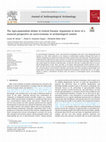
Journal of Anthropological Archaeology, 2022
[Free Full-Text Download Available through Sept 21, 2022: https://authors.elsevier.com/a/1fWRZ-JV... more [Free Full-Text Download Available through Sept 21, 2022: https://authors.elsevier.com/a/1fWRZ-JVbvBXC]
In central Eurasian archaeology, Soviet-and post-Soviet investigations and more recent biologically-focused analyses are often subtly presented as two extremes of archaeological synthesis, although both bodies of research complement one another and wrestle with similar questions about the human past. Through three case studies that marry 20th and 21st century research, we examine the archaeological context(s) of agro-pastoralism as one inroad to broader questions about past socio-economies. We argue that the archaeology of Bronze and Iron Age central Eurasia has reached an inflection point, in which the sum total of existing data allows us to move beyond identifications of what, where, and when, to the deeper anthropologically-oriented questions of who?, how?, and why? We draw from contemporary debates around the recognition and nature of agro-pastoralism in pre-and proto-historic central Eurasia to illustrate some specific cases where integrated research might more deeply probe the links between archaeological methods and interpretation. Flowing from this, we see opportunities to expand a self-reflective discussion about the process of archaeological inquiry and knowledge reproduction.
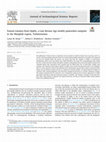
Journal of Archaeological Science: Reports, 2022
[Access the full article free until 21 Aug 2022 here: https://authors.elsevier.com/a/1fLHI,rVDBbx... more [Access the full article free until 21 Aug 2022 here: https://authors.elsevier.com/a/1fLHI,rVDBbx8S -- after that, please email me for a copy]
Abstract:
The publication of data relevant to prehistoric socio-economies in southern Central Asia is growing, and it intersects with long-standing questions about how mixed farming-herding subsistence economies were organized on local and regional scales. We present new faunal data from the campsite of Ojakly in south-central Turkmenistan, dated to the Late Bronze Age (1900-1500 BCE). We situate the zooarchaeological data within the site's overall excavation results and against similarly-contextualized fauna and archaeological remains from culturally-related sites, particularly those reported from the BMAC/Oxus site of Gonur-depe. Despite some overlaps in the domestic animal species utilized at Ojakly and at nearby farming-focused sites in the Murghab, there is a clear contrast in terms of the subsistence focus and practices, beyond what would be expected if these groups were specialized economic subsets of a single socio-cultural tradition. The faunal patterns at Ojakly are consistent with a pastoral population that exclusively managed mixed herds as a full-time subsistence strategy. The analysis presented here fits within the vein of identifying localized socioeconomic adaptations of mobile pastoralists, especially as they blur traditional notions of "nomadic" and "farming" economies. At the same time, they add to larger datasets of temporal and regional relevance, and they are discussed within broader patterns known from published material.
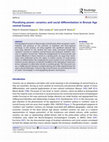
World Archaeology, 2021
Archaeological research on Bronze Age central Eurasia often recognizes 'exotic' materials and pra... more Archaeological research on Bronze Age central Eurasia often recognizes 'exotic' materials and practices as the outcome of migration and trans-regional exchange. In this analysis, we bring together two significant datasets that have long referred to one another but have rarely conversed analytically: 'southern' ceramics in northern central Eurasia and reciprocal 'northern' ceramics in southern Central Asia. Taking the amalgamation of technical traits and cultural affiliations in these ceramics as a starting point, we argue that 'exotic' wares were implicated across the region in diverse systems of social power reliant on differentiation. By comparing the social contexts of our northern and southern ceramic datasets, we identify variability in the signaling of 'exoticness' across subregions to alternately include or exclude groups. This discussion sets up a middle ground between overgeneralizing and under-hypothesizing the socio-cultural landscapes in Bronze Age central Eurasia, by prioritizing the role of 'exotic' technologies in choreographing dynamic social power.
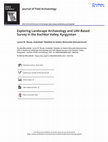
Journal of Field Archaeology, 2021
Free e-print download at: https://www.tandfonline.com/eprint/IB6JWIUWEX7AXA4YC87T/full?target=10.... more Free e-print download at: https://www.tandfonline.com/eprint/IB6JWIUWEX7AXA4YC87T/full?target=10.1080/00934690.2021.1945744
From the earliest archaeological investigations along Central Asia’s Tien Shan range, researchers have noted the diversity of highland communities and their participation in complex subsistence, exchange, and political systems. However, landscape archaeological approaches that might address socio-economic integrations have been limited by discontinuous, sometimes skewed datasets. Here, we present the results of UAV-based survey at Kok-Sai, an upland alluvial slope in the Kochkor Valley of north-central Kyrgyzstan, in which we identified more than 900 archaeological features in a 380 ha study area. Burials comprise roughly half of the identified features; stone structures, water catchments, irrigation channels, and terraces make up the other half. In an iterative interpretive process, we examine this busy landscape against high-resolution topographic and hydrological models, identifying repeated investment in the local physical and cultural infrastructure. Beyond the creation of a denser archaeological map for the area, the details of long-term, local landscape creation afforded by this study intersect with ongoing discussions of the organizational strategies and scales of highland agro-pastoralism.
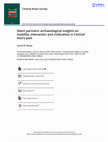
Central Asian Survey, 2020
Civilizations are as complex as the human relationships that engendered them, and outlining these... more Civilizations are as complex as the human relationships that engendered them, and outlining these relational qualities within open notions of mobility and interaction frames a reconceptualization of Central Asia’s past. Recent Eurasian archaeological research deconstructs deterministic political, economic or hierarchical typologies of civilization and the overly simplified narrative that roots it in urban centres perpetually juxtaposed with nomadic groups. Archaeological evidence from the Oxus Civilization, Central Asia’s earliest complex polity (ca. 2500–1400 BCE), reveals the deep roots of sedentary–mobile interactions. I argue that Oxus–steppe relationships helped maintain the long-term structural cohesion of the Oxus Civilization as a multicultural entity, with implications for subsequent Central Asian polities. As we begin to balance the lopsided conversations about the social formations of Central Asia’s past and present, the silent partnership that characterized the Oxus Civilization is given a voice that forces us to reconsider who, exactly, belongs inside our notions of civilization.
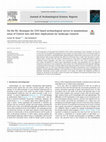
Journal of Archaeological Science: Reports, 2020
The incorporation of Unmanned Aerial Vehicles (UAVs) within archaeological survey strategies over... more The incorporation of Unmanned Aerial Vehicles (UAVs) within archaeological survey strategies over the past several years has broadened the geographical scale of inquiry for many projects, led to an increased number of recorded sites and features, and fundamentally shifted interpretive frameworks in many parts of the world. The high-resolution, full-coverage landscape data offered by UAV-based survey would seem well suited to archaeological study in Central Asia; the region is characterized by a long history of fragmented land-use patterns, variegated cultural geography, and niche local environments. However, UAV survey strategies have not been widely incorporated in Central Asian archaeological research, and subsequently have not impacted interpretative processes in ways comparable to other regions. Part of the problem lies in the logistical challenges of operating UAVs in the areas of remote (offline) and rough terrain typical of much of Central Asia, and to this methodological issue we offer some field-tested strategies developed in mountainous areas of Kyrgyzstan and Tajikistan. Another significant challenge to UAV-based survey in Central Asia lies in the ongoing development of landscape archaeology as both concept and practice in the region. We address this disciplinary problem by framing our discussion in the broader context of the gains and challenges UAV-generated datasets bring to the interpretation of Central Asian landscapes.

The highlands of Central Asia posed considerable challenges to early agriculturalists, yet the pr... more The highlands of Central Asia posed considerable challenges to early agriculturalists, yet the processes of human subsistence strategies there remain poorly understood. In this paper, we present results from the excavation of the Chap in Kyrgyzstan. The recovery of a rich macrobotanical assemblage consisting of several crop species and crop processing debris, together with skeletal remains of pastoral livestock, indicate a localized agro-pastoral complex at 2000 masl dating to 1065–825 cal b.c. Aerial photogrammetry, magnetometry, and topographic modeling reveal local irrigation systems, while stone artifacts are linked with cultivation and crop processing. Furthermore, the ceramic assemblage reveals a local production tradition and stylistic similarities with communities of neighboring regions. Overall, data from Chap contribute to a new understanding of human ecology and agricultural development in the mountains of Central Asia, suggesting that domesticated plants and animals were integral for the intensive occupation of high-elevation valleys in Central Asia.
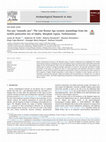
Archaeological Research in Asia, 2019
Recent archaeological research in the Murghab region of modern Turkmenistan has highlighted the v... more Recent archaeological research in the Murghab region of modern Turkmenistan has highlighted the variable interweaving of material, technological, and social traditions between sedentary farmers and mobile pastoralists during the late 3rd through first half of the 2nd millennium BCE. This research has also made apparent significant gaps in collective scientific knowledge, particularly in relation to the materials and habits of mobile pastoralists. In this paper, we address the lack of a basic quantitative and qualitative description of mobile pastoralist ceramics for the prehistoric Murghab by presenting the results of a multi-faceted ceramic analysis for the occupation at Ojakly. Results demonstrate a greater degree of variability in form, function, and style of handmade coarseware than expected, calling into question the characterization of "nomadic jars" as a uniform type of material culture, and further emphasizing the plurality of mobile pastoralist strategies and behaviors in this key region.
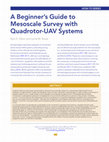
Advances in Archaeological Practice, 2018
Archaeologists were early adopters of Unmanned Aerial Vehicle (UAV) systems, extending a long tra... more Archaeologists were early adopters of Unmanned Aerial Vehicle (UAV) systems, extending a long tradition of low-altitude aerial photography for site documentation and landscape survey (Verhoeven 2009, 2011). UAV use in archaeology has accelerated recently, given the affordability of “out-of-the-box” quadrotor-UAV platforms and the reduced cost of photogrammetric software for processing drone-produced imagery (Gutiérrez and Searcy 2016). While quadrotor UAVs may represent more technical firepower than strictly necessary for micro-scale documentation, i.e. excavation units or individual features, recent reviews concur that they are not efficient enough platforms for the macro-scale, i.e. broad exploratory landscape survey and aerial reconnaissance (Campana 2017: 15; Colomina and Molina 2014). These low-cost and easy-to-use platforms therefore seem best suited for covering the meso-scale, including the level of entire sites and their catchment areas (Campana 2017: 5; Hill and Rowan 2017). Furthermore, quadrotor UAV systems represent a feasible entry-level option for archaeological projects with limited budgets or non-specialist personnel who are interested in producing technical quality aerial photographs and digital elevation models to answer research questions rather than for illustration alone (Lang et al. 2016; Parcero-Oubiña et al. 2016).
This article outlines the primary phases of research using a quadrotor UAV to address meso-scale research problems. In our own experience, we found a gap in the UAV literature between technical/operational manuals and the interpretation(s) of post-processed imagery (but see Barnes and Volkmann 2015). Our aim in this paper is to partially fill this gap, emphasizing the needs of projects based in remote locales with limited internet access. Our target audience is non-specialist or novice UAV operators who may find themselves, as we did, with an out-of-the-box drone and software package, a particular set of research aims to tackle in difficult and remote field conditions, and with little guidance on how to practically link these within the scope of a field project. We therefore focus on planning, implementing, and troubleshooting meso-scale UAV survey, and the processing of imagery for orthophoto and topographic map production.
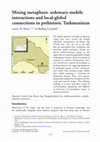
Antiquity, 2018
The deeply engrained stereotype of opposing ‘steppe’ and ‘sown’ societies has strongly influenced... more The deeply engrained stereotype of opposing ‘steppe’ and ‘sown’ societies has strongly influenced interpretation of Bronze Age Central Asia. This has led to the idea that the agricultural Oxus civilisation and non-Oxus mobile pastoralists formed two distinct cultural-economic groups in this region that are easily distinguishable through archaeological remains. Recent excavations of campsites in southern Turkmenistan, however, provide new evidence of variability in exchange between sites, suggesting adaptation by pastoralist groups in their interactions with settled Oxus farming groups. Rather than wholly reiterating or dissolving the distinctions between them, such practices dynamically reshaped the boundaries of these social and economic groups throughout Central Asia. These findings challenge us to move away from notions of centre-periphery, dependency and diffusion in discussions of inter-cultural contact in Eurasian prehistory.
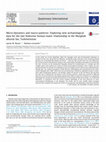
Quaternary International, 2017
In this article we re-visit hypotheses about the changing social and environmental landscapes in ... more In this article we re-visit hypotheses about the changing social and environmental landscapes in southern Central Asia during the late Holocene, specifically giving attention to the transitional period between the archaeologically-defined Late Bronze e Early Iron Age (second half of the 2nd millennium BC) and the numerous documented changes in the archaeological and physio-geographical record during this time. We focus on the northeastern Murghab alluvial fan (Turkmenistan) as a window into this complex period, and examine one aspect of human-environmental dynamics there, namely, the relationship between the location of archaeological sites and mapped ancient watercourses (palaeochannels) through time. Our analysis incorporates nearly 400 new archaeological sites documented in the northeastern Murghab since 2006, which have not previously been included in published models of settlement and/or hydrological dynamics. Our findings suggest the periods of the Late Bronze Age and Early Iron Age (Yaz I) demonstrate two distinct access-to-water practices, which may correlate to different processes of socio-territorial control being implemented. While no single line of evidence can adequately disentangle the complex interconnected processes of environmental and social change, our results lend themselves to integration with the current working knowledge of the local processes of socio-environmental development in the Murghab. The results also fit more broadly within emerging discourse that recognizes the importance of micro-scale processes and adaptation in Eurasian prehistory.
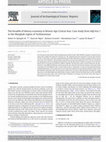
Over the past decade research into the paleoeconomy of Bronze Age (3500–800 BCE) peoples in Centr... more Over the past decade research into the paleoeconomy of Bronze Age (3500–800 BCE) peoples in Central Asia has shown how complex the productive economy was. The agropastoral system involved an array of crops and herd animals. In this article,we present a paleoethnobotanical study conducted on sediment samples from excavation units at the site of Adji Kui 1, Turkmenistan. Excavations at the site were conducted in 2013; the site is located on the northeastern part of the Murghab Alluvial Fan in the Kara Kum Desert. Earlier excavations at the site have shown that its occupation spanned from 2400 to 1300 BCE. The botanical remains recovered from the site illustrate that a very different landscape existed around the site in the past and that the economy was heavily reliant on farming of several different crops, as well as wild resources. In this paper,we present macrobotanical remains of wild foraged plants, such as fruits and nuts. We show that in addition to meat and dairy products, people at the site fished for small stream fish.We also present evidence for an array of cultivated grains and legumes; among the grains we identified hulled and naked barley, broomcorn millet, and free-threshingwheat;we also identified peas, lentils, grass peas, bitter vetch, and fava bean. Ultimately, we attempt to lay out part of the early stages of development of a Central Asian cuisine.
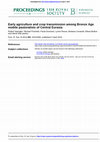
Proceedings of the Royal Society B, Apr 2, 2014
"Archaeological research in Central Eurasia is exposing unprecedented scales of trans-regional in... more "Archaeological research in Central Eurasia is exposing unprecedented scales of trans-regional interaction and technology transfer between East Asia and southwest Asia deep into the prehistoric past. This article presents a new archaeobotanical analysis from pastoralist campsites in the mountain and desert regions of Central Eurasia that documents the oldest known evidence for domesticated grains and farming among seasonally mobile herders. Carbonized grains from the sites of Tasbas and Begash illustrate the first transmission of southwest Asian and East Asian domesticated grains into the mountains of Inner Asia in the early third millennium BC. By the middle second millennium BC, seasonal camps in the mountains and deserts illustrate that Eurasian herders incorporated the cultivation of millet, wheat, barley and legumes into their subsistence strategy. These findings push back the chronology for domesticated plant use among Central Eurasian pastoralists by approximately 2000 years. Given the geography, chronology and seed morphology of these data, we argue that mobile pastoralists were key agents in the spread of crop repertoires and the transformation of agricultural economies across Asia from the third to the second millennium BC."

Journal of Vegetation History and Archaeobotany, Mar 2014
Archaeological investigations of pastoral economies often emphasize exchange relations with agric... more Archaeological investigations of pastoral economies often emphasize exchange relations with agricultural populations, though for Bronze Age Eurasia the notion of a ubiquitous ‘pastoral realm’ has masked various forms of mixed subsistence economies. In Central Asia, there are few attempts to specifically identify the domestic crops utilized by mobile pastoralists or what they may suggest about the role of agriculture in mobile pastoral production or subsistence strategies. This study reports the macrobotanical remains from two Late/Final Bronze Age (ca. 1950–1300 BC) mobile pastoralist habitation sites in the Murghab alluvial fan region of southern Turkmenistan. We compare our results with published macrobotanical data from contemporary agricultural settlements in the Murghab region, as well as with other sites in broader prehistoric Eurasia. We find that mobile pastoralists in the Murghab utilized some of the same domestic crops as their sedentary neighbors. While the data presented here do not preclude the possibility that mobile pastoralists may have practiced some low-investment cultivation (particularly of millet),
we hypothesize an economic model that places mobile pastoralists in direct contact with nearby sedentary farming communities through exchange for pre-processed grains. These results highlight one of the possible strategies of mobile pastoral subsistence in Central Asia, and are a further step toward identifying the various degrees of agricultural involvement in the conceptually outdated pastoral realm of Eurasia.
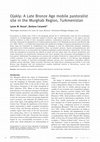
Journal of Field Archaeology v39-1, Feb 2014
Excavations at Ojakly (site 1744) in the Murghab alluvial fan in Turkmenistan mark the first syst... more Excavations at Ojakly (site 1744) in the Murghab alluvial fan in Turkmenistan mark the first systematic collection of archaeological materials related to Bronze Age mobile pastoralists in the region, and the earliest evidence to date of their occupation patterns, subsistence practices, and ceramic production activities. Because the appearance of mobile pastoral groups in the Murghab during the Late Bronze Age (ca. 1950–1500 B.C.) is traditionally associated with significant changes in regional sociopolitical structures, these data are important for establishing local strategies of and the relationship between sedentary agricultural and mobile pastoral populations. Here, we present ceramic, faunal, archaeobotanical, and lithic data that force us to reconsider the traditional sedentary-mobile dichotomy. Specifically, we find that while the subsistence economies are distinct at urban and non-urban sites, the ceramic production and trade interactions are significantly intertwined and more complex than previously acknowledged for this time period. Additionally, the presence of a ceramic kiln at Ojakly (Turkmen for ‘‘place with kiln’’) containing unfired ceramics of a type typically associated with sedentary farmers in the Bronze Age Murghab suggests the transfer of technical knowledge between groups who nevertheless maintained distinct material cultural identities. Ojakly provides important new data about coexisting economies in the Late Bronze Age Murghab that can productively unsettle traditional notions of dominance, control, and polarization in sedentary-mobile interactions.
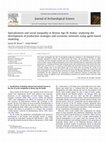
Journal of Archaeological Science, Jul 2011
This paper investigates the role of specialized production strategies in the development of socio... more This paper investigates the role of specialized production strategies in the development of socioeconomic inequalities in Bronze Age south-eastern (SE) Arabia, and particularly, the ways in which a localized, internal exchange economy may have produced stress and instability in the SE Arabian socio-economic system. While archaeological research has established that the communities of SE Arabia participated in a widespread Bronze Age exchange system that included areas of the ancient Near East, South Asia, and Central Asia, it is unclear to what degree this interaction fostered the broad-scale socioeconomic changes seen in the Early Bronze Age of SE Arabia. Here we present the results of an agent-based model that suggest the nature of the internal exchange economy in SE Arabia itself may have precipitated the social conditions necessary for change by allowing individuals to profit disproportionately. We thus emphasize the importance of local production strategies in generating socioeconomic change, in addition to the well-established economic and cultural contacts with the wider Bronze Age world.
Book Chapters/Sections by Lynne M. Rouse
Urban Cultures of Central Asia from the Bronze Age to the Karakhanids, 2019
A Companion to the Archaeology of the Ancient Near East, First Edition. Edited by D.T. Potts, 2012
The Oxford Companion to Archaeology, Second Edition, ed. N. Asher Silberman. Oxford: Oxford University Press., 2012







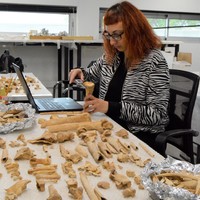
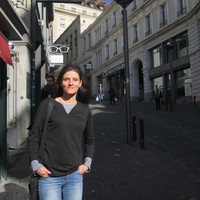

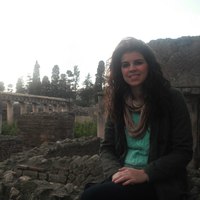
Uploads
Journal Articles by Lynne M. Rouse
In central Eurasian archaeology, Soviet-and post-Soviet investigations and more recent biologically-focused analyses are often subtly presented as two extremes of archaeological synthesis, although both bodies of research complement one another and wrestle with similar questions about the human past. Through three case studies that marry 20th and 21st century research, we examine the archaeological context(s) of agro-pastoralism as one inroad to broader questions about past socio-economies. We argue that the archaeology of Bronze and Iron Age central Eurasia has reached an inflection point, in which the sum total of existing data allows us to move beyond identifications of what, where, and when, to the deeper anthropologically-oriented questions of who?, how?, and why? We draw from contemporary debates around the recognition and nature of agro-pastoralism in pre-and proto-historic central Eurasia to illustrate some specific cases where integrated research might more deeply probe the links between archaeological methods and interpretation. Flowing from this, we see opportunities to expand a self-reflective discussion about the process of archaeological inquiry and knowledge reproduction.
Abstract:
The publication of data relevant to prehistoric socio-economies in southern Central Asia is growing, and it intersects with long-standing questions about how mixed farming-herding subsistence economies were organized on local and regional scales. We present new faunal data from the campsite of Ojakly in south-central Turkmenistan, dated to the Late Bronze Age (1900-1500 BCE). We situate the zooarchaeological data within the site's overall excavation results and against similarly-contextualized fauna and archaeological remains from culturally-related sites, particularly those reported from the BMAC/Oxus site of Gonur-depe. Despite some overlaps in the domestic animal species utilized at Ojakly and at nearby farming-focused sites in the Murghab, there is a clear contrast in terms of the subsistence focus and practices, beyond what would be expected if these groups were specialized economic subsets of a single socio-cultural tradition. The faunal patterns at Ojakly are consistent with a pastoral population that exclusively managed mixed herds as a full-time subsistence strategy. The analysis presented here fits within the vein of identifying localized socioeconomic adaptations of mobile pastoralists, especially as they blur traditional notions of "nomadic" and "farming" economies. At the same time, they add to larger datasets of temporal and regional relevance, and they are discussed within broader patterns known from published material.
From the earliest archaeological investigations along Central Asia’s Tien Shan range, researchers have noted the diversity of highland communities and their participation in complex subsistence, exchange, and political systems. However, landscape archaeological approaches that might address socio-economic integrations have been limited by discontinuous, sometimes skewed datasets. Here, we present the results of UAV-based survey at Kok-Sai, an upland alluvial slope in the Kochkor Valley of north-central Kyrgyzstan, in which we identified more than 900 archaeological features in a 380 ha study area. Burials comprise roughly half of the identified features; stone structures, water catchments, irrigation channels, and terraces make up the other half. In an iterative interpretive process, we examine this busy landscape against high-resolution topographic and hydrological models, identifying repeated investment in the local physical and cultural infrastructure. Beyond the creation of a denser archaeological map for the area, the details of long-term, local landscape creation afforded by this study intersect with ongoing discussions of the organizational strategies and scales of highland agro-pastoralism.
This article outlines the primary phases of research using a quadrotor UAV to address meso-scale research problems. In our own experience, we found a gap in the UAV literature between technical/operational manuals and the interpretation(s) of post-processed imagery (but see Barnes and Volkmann 2015). Our aim in this paper is to partially fill this gap, emphasizing the needs of projects based in remote locales with limited internet access. Our target audience is non-specialist or novice UAV operators who may find themselves, as we did, with an out-of-the-box drone and software package, a particular set of research aims to tackle in difficult and remote field conditions, and with little guidance on how to practically link these within the scope of a field project. We therefore focus on planning, implementing, and troubleshooting meso-scale UAV survey, and the processing of imagery for orthophoto and topographic map production.
we hypothesize an economic model that places mobile pastoralists in direct contact with nearby sedentary farming communities through exchange for pre-processed grains. These results highlight one of the possible strategies of mobile pastoral subsistence in Central Asia, and are a further step toward identifying the various degrees of agricultural involvement in the conceptually outdated pastoral realm of Eurasia.
Book Chapters/Sections by Lynne M. Rouse
In central Eurasian archaeology, Soviet-and post-Soviet investigations and more recent biologically-focused analyses are often subtly presented as two extremes of archaeological synthesis, although both bodies of research complement one another and wrestle with similar questions about the human past. Through three case studies that marry 20th and 21st century research, we examine the archaeological context(s) of agro-pastoralism as one inroad to broader questions about past socio-economies. We argue that the archaeology of Bronze and Iron Age central Eurasia has reached an inflection point, in which the sum total of existing data allows us to move beyond identifications of what, where, and when, to the deeper anthropologically-oriented questions of who?, how?, and why? We draw from contemporary debates around the recognition and nature of agro-pastoralism in pre-and proto-historic central Eurasia to illustrate some specific cases where integrated research might more deeply probe the links between archaeological methods and interpretation. Flowing from this, we see opportunities to expand a self-reflective discussion about the process of archaeological inquiry and knowledge reproduction.
Abstract:
The publication of data relevant to prehistoric socio-economies in southern Central Asia is growing, and it intersects with long-standing questions about how mixed farming-herding subsistence economies were organized on local and regional scales. We present new faunal data from the campsite of Ojakly in south-central Turkmenistan, dated to the Late Bronze Age (1900-1500 BCE). We situate the zooarchaeological data within the site's overall excavation results and against similarly-contextualized fauna and archaeological remains from culturally-related sites, particularly those reported from the BMAC/Oxus site of Gonur-depe. Despite some overlaps in the domestic animal species utilized at Ojakly and at nearby farming-focused sites in the Murghab, there is a clear contrast in terms of the subsistence focus and practices, beyond what would be expected if these groups were specialized economic subsets of a single socio-cultural tradition. The faunal patterns at Ojakly are consistent with a pastoral population that exclusively managed mixed herds as a full-time subsistence strategy. The analysis presented here fits within the vein of identifying localized socioeconomic adaptations of mobile pastoralists, especially as they blur traditional notions of "nomadic" and "farming" economies. At the same time, they add to larger datasets of temporal and regional relevance, and they are discussed within broader patterns known from published material.
From the earliest archaeological investigations along Central Asia’s Tien Shan range, researchers have noted the diversity of highland communities and their participation in complex subsistence, exchange, and political systems. However, landscape archaeological approaches that might address socio-economic integrations have been limited by discontinuous, sometimes skewed datasets. Here, we present the results of UAV-based survey at Kok-Sai, an upland alluvial slope in the Kochkor Valley of north-central Kyrgyzstan, in which we identified more than 900 archaeological features in a 380 ha study area. Burials comprise roughly half of the identified features; stone structures, water catchments, irrigation channels, and terraces make up the other half. In an iterative interpretive process, we examine this busy landscape against high-resolution topographic and hydrological models, identifying repeated investment in the local physical and cultural infrastructure. Beyond the creation of a denser archaeological map for the area, the details of long-term, local landscape creation afforded by this study intersect with ongoing discussions of the organizational strategies and scales of highland agro-pastoralism.
This article outlines the primary phases of research using a quadrotor UAV to address meso-scale research problems. In our own experience, we found a gap in the UAV literature between technical/operational manuals and the interpretation(s) of post-processed imagery (but see Barnes and Volkmann 2015). Our aim in this paper is to partially fill this gap, emphasizing the needs of projects based in remote locales with limited internet access. Our target audience is non-specialist or novice UAV operators who may find themselves, as we did, with an out-of-the-box drone and software package, a particular set of research aims to tackle in difficult and remote field conditions, and with little guidance on how to practically link these within the scope of a field project. We therefore focus on planning, implementing, and troubleshooting meso-scale UAV survey, and the processing of imagery for orthophoto and topographic map production.
we hypothesize an economic model that places mobile pastoralists in direct contact with nearby sedentary farming communities through exchange for pre-processed grains. These results highlight one of the possible strategies of mobile pastoral subsistence in Central Asia, and are a further step toward identifying the various degrees of agricultural involvement in the conceptually outdated pastoral realm of Eurasia.
https://authors.elsevier.com/c/1fWRZ-JVbvBXC
In central Eurasian archaeology, Soviet- and post-Soviet investigations and more recent biologically-focused analyses are often subtly presented as two extremes of archaeological synthesis, although both bodies of research complement one another and wrestle with similar questions about the human past. Through three case studies that marry 20th and 21st century research, we examine the archaeological context(s) of agro-pastoralism as one inroad to broader questions about past socio-economies. We argue that the archaeology of Bronze and Iron Age central Eurasia has reached an inflection point, in which the sum total of existing data allows us to move beyond identifications of what, where, and when, to the deeper anthropologically-oriented questions of who?, how?, and why? We draw from contemporary debates around the recognition and nature of agro-pastoralism in pre- and proto-historic central Eurasia to illustrate some specific cases where integrated research might more deeply probe the links between archaeological methods and interpretation. Flowing from this, we see opportunities to expand a self-reflective discussion about the process of archaeological inquiry and knowledge reproduction.
economies often emphasize exchange relations with agricultural
populations, though for Bronze Age Eurasia the
notion of a ubiquitous ‘pastoral realm’ has masked various
forms of mixed subsistence economies. In Central Asia,
there are few attempts to specifically identify the domestic
crops utilized by mobile pastoralists or what they may
suggest about the role of agriculture in mobile pastoral
production or subsistence strategies. This study reports the
macrobotanical remains from two Late/Final Bronze Age
(ca. 1950–1300 BC) mobile pastoralist habitation sites in the
Murghab alluvial fan region of southern Turkmenistan. We
compare our results with published macrobotanical data
from contemporary agricultural settlements in the Murghab
region, as well as with other sites in broader prehistoric
Eurasia. We find that mobile pastoralists in the Murghab
utilized some of the same domestic crops as their sedentary
neighbors. While the data presented here do not preclude
the possibility that mobile pastoralists may have practiced
some low-investment cultivation (particularly of millet),
we hypothesize an economic model that places mobile
pastoralists in direct contact with nearby sedentary farming
communities through exchange for pre-processed grains.
These results highlight one of the possible strategies of
mobile pastoral subsistence in Central Asia, and are a
further step toward identifying the various degrees of
agricultural involvement in the conceptually outdated
pastoral realm of Eurasia.
of trans-regional interaction and technology transfer between East Asia and
southwest Asia deep into the prehistoric past. This article presents a new
archaeobotanical analysis from pastoralist campsites in the mountain and
desert regions of Central Eurasia that documents the oldest known evidence
for domesticated grains and farming among seasonally mobile herders.
Carbonized grains from the sites of Tasbas and Begash illustrate the first transmission
of southwest Asian and East Asian domesticated grains into the
mountains of Inner Asia in the early third millennium BC. By the middle
second millennium BC, seasonal camps in the mountains and deserts illustrate
that Eurasian herders incorporated the cultivation of millet, wheat, barley
and legumes into their subsistence strategy. These findings push back the
chronology for domesticated plant use among Central Eurasian pastoralists
by approximately 2000 years. Given the geography, chronology and seed
morphology of these data, we argue that mobile pastoralists were key agents
in the spread of crop repertoires and the transformation of agricultural
economies across Asia from the third to the second millennium BC.